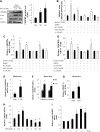Pak1 mediates the stimulatory effect of insulin and curcumin on hepatic ChREBP expression
- PMID: 28992163
- PMCID: PMC5907843
- DOI: 10.1093/jmcb/mjx031
Pak1 mediates the stimulatory effect of insulin and curcumin on hepatic ChREBP expression
Abstract
Insulin can stimulate hepatic expression of carbohydrate-responsive element-binding protein (ChREBP). As recent studies revealed potential metabolic beneficial effects of ChREBP, we asked whether its expression can also be regulated by the dietary polyphenol curcumin. We also aimed to determine mechanisms underlying ChREBP stimulation by insulin and curcumin. The effect of insulin on ChREBP expression was assessed in mouse hepatocytes, while the effect of curcumin was assessed in mouse hepatocytes and with curcumin gavage in mice. Chemical inhibitors for insulin signaling molecules were utilized to identify involved signaling molecules, and the involvement of p21-activated protein kinase 1 (Pak1) was determined with its chemical inhibitor and Pak1-/- hepatocytes. We found that both insulin and curcumin-stimulated ChREBP expression in Akt-independent but MEK/ERK-dependent manner, involving the inactivation of the transcriptional repressor Oct-1. Aged Pak1-/- mice showed reduced body fat volume. Pak1 inhibition or its genetic deletion attenuated the stimulatory effect of insulin or curcumin on ChREBP expression. Our study hence suggests the existence of a novel signaling cascade Pak1/MEK/ERK/Oct-1 for both insulin and curcumin in exerting their glucose-lowering effect via promoting hepatic ChREBP production, supports the recognition of beneficial functions of ChREBP, and brings us a new overview on dietary polyphenols.
Keywords: Akt; ChREBP; Oct-1; Pak1; curcumin; dietary polyphenol intervention; insulin.
© The Author (2017). Published by Oxford University Press on behalf of Journal of Molecular Cell Biology, IBCB, SIBS, CAS. All rights reserved.
Figures






Similar articles
-
Insulin stimulates the expression of carbohydrate response element binding protein (ChREBP) by attenuating the repressive effect of Pit-1, Oct-1/Oct-2, and Unc-86 homeodomain protein octamer transcription factor-1.Endocrinology. 2009 Aug;150(8):3483-92. doi: 10.1210/en.2008-1702. Epub 2009 Apr 9. Endocrinology. 2009. PMID: 19359385
-
The lipogenic transcription factor ChREBP dissociates hepatic steatosis from insulin resistance in mice and humans.J Clin Invest. 2012 Jun;122(6):2176-94. doi: 10.1172/JCI41636. Epub 2012 May 1. J Clin Invest. 2012. PMID: 22546860 Free PMC article. Clinical Trial.
-
Distinct regulation of adiponutrin/PNPLA3 gene expression by the transcription factors ChREBP and SREBP1c in mouse and human hepatocytes.J Hepatol. 2011 Jul;55(1):145-53. doi: 10.1016/j.jhep.2010.10.024. Epub 2010 Nov 30. J Hepatol. 2011. PMID: 21145868
-
ChREBP: a glucose-activated transcription factor involved in the development of metabolic syndrome.Endocr J. 2008 Aug;55(4):617-24. doi: 10.1507/endocrj.k07e-110. Epub 2008 May 19. Endocr J. 2008. PMID: 18490833 Review.
-
The Role of Carbohydrate Response Element Binding Protein in Intestinal and Hepatic Fructose Metabolism.Nutrients. 2017 Feb 22;9(2):181. doi: 10.3390/nu9020181. Nutrients. 2017. PMID: 28241431 Free PMC article. Review.
Cited by
-
Curcumin and dietary polyphenol research: beyond drug discovery.Acta Pharmacol Sin. 2018 May;39(5):779-786. doi: 10.1038/aps.2017.179. Epub 2018 Mar 15. Acta Pharmacol Sin. 2018. PMID: 29542686 Free PMC article. Review.
-
Astaxanthin attenuates glucose-induced liver injury in largemouth bass: role of p38MAPK and PI3K/Akt signaling pathways.Cell Biosci. 2024 Sep 19;14(1):122. doi: 10.1186/s13578-024-01304-7. Cell Biosci. 2024. PMID: 39300527 Free PMC article.
-
Activation of the mitogen-activated protein kinase ERK1/2 signaling pathway suppresses the expression of ChREBPα and β in HepG2 cells.FEBS Open Bio. 2021 Jul;11(7):2008-2018. doi: 10.1002/2211-5463.13208. Epub 2021 Jun 17. FEBS Open Bio. 2021. PMID: 34051057 Free PMC article.
-
Dietary Cyanidin-3-Glucoside Attenuates High-Fat-Diet-Induced Body-Weight Gain and Impairment of Glucose Tolerance in Mice via Effects on the Hepatic Hormone FGF21.J Nutr. 2020 Aug 1;150(8):2101-2111. doi: 10.1093/jn/nxaa140. J Nutr. 2020. PMID: 32470979 Free PMC article.
-
Biombalance™, an Oligomeric Procyanidins-Enriched Grape Seed Extract, Prevents Inflammation and Microbiota Dysbiosis in a Mice Colitis Model.Antioxidants (Basel). 2025 Mar 1;14(3):305. doi: 10.3390/antiox14030305. Antioxidants (Basel). 2025. PMID: 40227242 Free PMC article.
References
-
- Amiot M.J., Riva C., and Vinet A. (2016). Effects of dietary polyphenols on metabolic syndrome features in humans: a systematic review. Obes. Rev. 17, 573–586. - PubMed
-
- Anhe F.F., Roy D., Pilon G., et al. . (2015). A polyphenol-rich cranberry extract protects from diet-induced obesity, insulin resistance and intestinal inflammation in association with increased Akkermansia spp. population in the gut microbiota of mice. Gut 64, 872–883. - PubMed
-
- Cai X.Z., Wang J., Li X.D., et al. . (2009). Curcumin suppresses proliferation and invasion in human gastric cancer cells by downregulation of PAK1 activity and cyclin D1 expression. Cancer Biol. Ther. 8, 1360–1368. - PubMed
MeSH terms
Substances
Grants and funding
LinkOut - more resources
Full Text Sources
Other Literature Sources
Medical
Molecular Biology Databases
Research Materials
Miscellaneous

